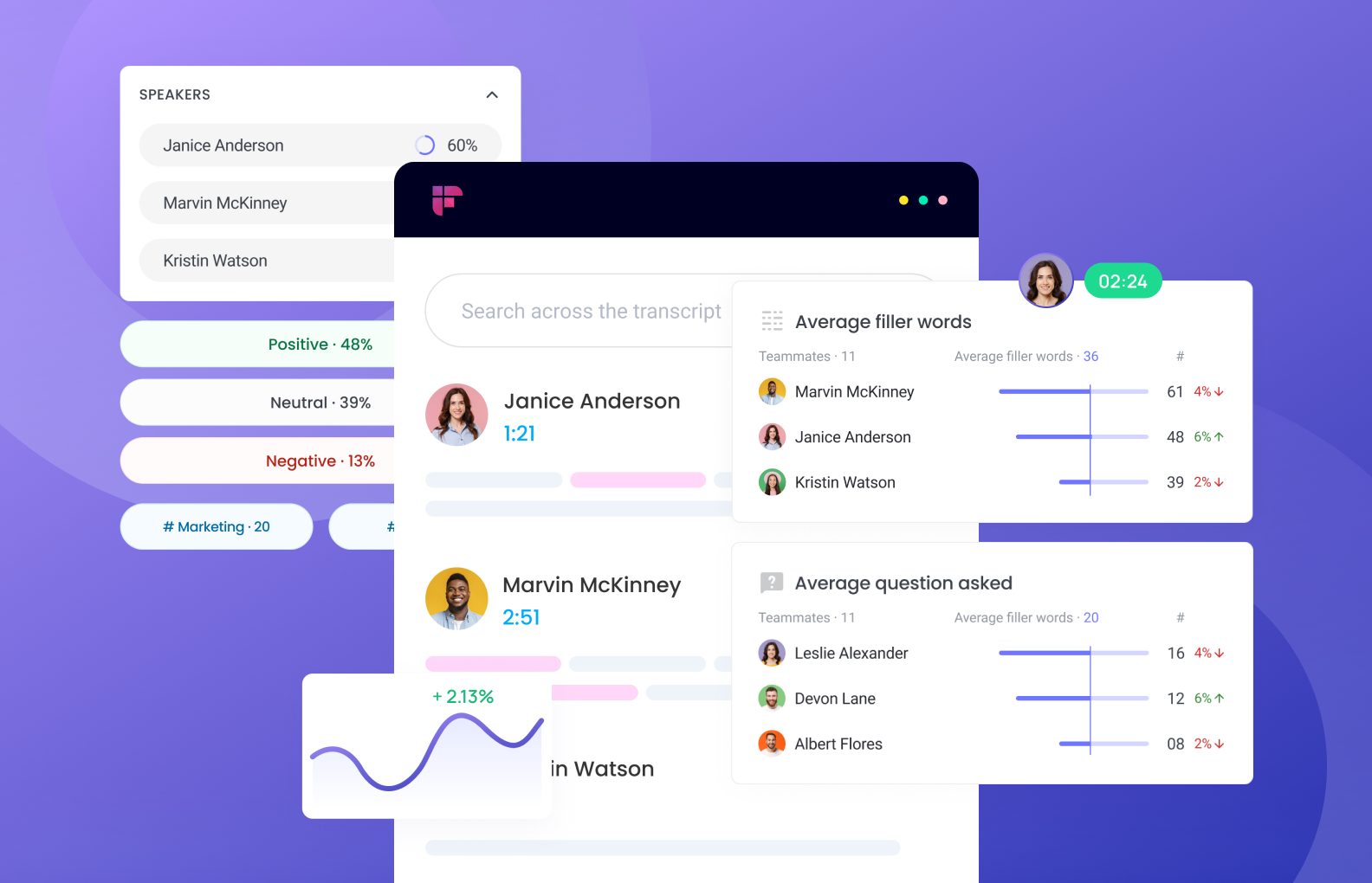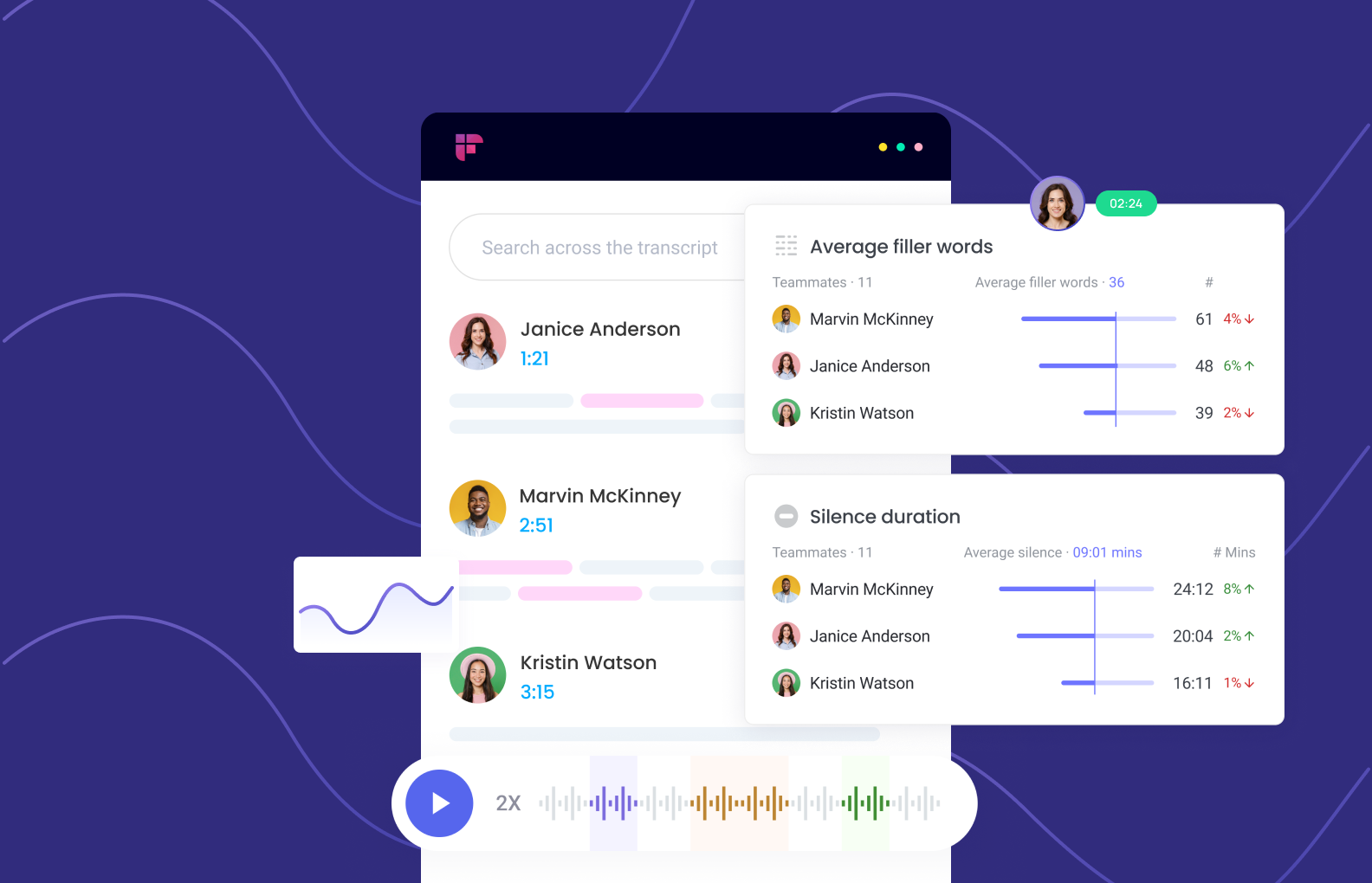Let this sink in:
According to CSO Insights Sales Manager Enablement Report:
- 75% of sales organizations waste resources due to random and informal coaching approaches.
- Organizations with dynamic sales coaching programs achieve 28% higher win rates.
- More than 60% of salespeople are more likely to quit their job if their manager is a poor coach.
- Over 47% of sales managers do not spend 30 minutes per week coaching reps on behaviors and skills.
Despite several benefits, sales coaching is challenging. Why? Because effectively coaching sales reps of varying skill levels across multiple locations is a juggling act.
As a result, coaching happens infrequently, sometimes not at all. It's one of the key factors for missing revenue targets and sales team turnover.
Let's change this by making sales coaching 5X easier and better.
Fireflies for Effective Sales Coaching
Quickly onboard new sales hires
You, and salespeople in general, are driven. No doubt about that. You're eager to hit your target quotas from the get-go.
Yet onboarding can slow you down. Well, ineffective onboarding of new sales hires, that is.
According to the 2019 SaaS AE Report by BridgeGroup, the average ramp time for a rep is 4.2 months. Add to it the burden of onboarding remotely.
It makes it challenging for new reps to complete one of the most common training processes (i.e., shadowing live sales calls).
Fireflies makes it easier for new reps to learn from the best, no matter where they work. It’s the driving force behind any new hire's ramp-up ability.
With Fireflies, you can record, transcribe, and share transcripts and calls of top performers with new hires. By using Fireflies, shadowing live sales calls is more of an option than a rule for new hires.
They can listen to a vast trove of calls from start to finish, nail down the best sales pitches, insightful questions, and other key moments in their own time.
And they can easily access all these recordings and transcript in one secure place: Fireflies Notebook. Think of it as a time capsule for all your sales calls.
Identify and analyze sales trends
If you want your team to perform well every month and crush quotas without fail, intuition and guesswork won't help.
Effective sales coaching relies on your ability to analyze trends and patterns.
Let's say you want to understand the reason for a low win rate for the quarter. You suspect that it could be an ineffective or outdated sales approach.
So you start reviewing your sales team’s calls. And this is where the game changes.
Fireflies Conversation Intelligence software equips managers with the right insights and capabilities to set their team up for long-term success through effective sales coaching.
With Fireflies Conversation Intelligence suite of features, you can easily see how your entire sales team is performing at a glance. It provides critical sales coaching data like:

1) Are your SDRs, BDRs, and AEs asking the right questions?
"Ask the right questions if you're to find the right answers" ~ Vanessa Redgrave.
There is a reason why this saying holds true in sales. Whether qualifying a lead or probing deep into a discovery call, BDRs, SDRs, and AEs must ask the right questions to better understand their customers' most pressing business issues. This helps sales reps propose the right solutions.
Unfortunately, most salespeople have been trained to "interrogate" prospects with a list of questions that create walls instead of earning trust.
Conversation intelligence ensures your reps are asking the right question and saying the right things.
Conversation intelligence gives you insights into how many questions were asked during a call, both at an individual or team level. You can see the type of questions your rep is asking and course-correct accordingly.
Not only that. You can leave comments, feedback, and suggestions on the Thread section of Fireflies Notebook.
2) Is your team calling more or less?
Cold calling is dead. Take it with a grain of salt if anyone tells you that. That's because 82% of buyers admitted to having accepted meetings with sales reps after a series of touchpoints that started with cold calls.
Calling is critical to sales and essential for converting buyers into customers. With Fireflies Conversation Intelligence, you can see how many calls your reps make by reviewing the total number of conversations.
Let's say, your Fireflies Conversation Intelligence data is telling you that one of your AE's just spent 94 hours doing sales calls the previous week.
Is that impressive? Definitely. But his win-rate is barely 10%. The effort doesn’t match the outcome. Why is that?
He’s a hard-working AE. We’ve already established that. He probably just needs more sales coaching or a better playbook.
3) How much do your reps talk vs. listen
"Willy: I don't know why—I can't stop myself— I talk too much. A man oughta come in with a few words. Charlie's a man of few words, and they respect him." - Death of a Salesman by Arthur Miller.
We all sympathize with Willy in Death of a Salesman—he knew he talked too much but didn't know why. He wanted to be like Charlie, who was respected by all for being a man of a few words.
Luckily, this is no longer a problem in the day and age of AI and conversation intelligence. Active listening is essential in sales.
Fireflies' conversation intelligence lets you analyze how much your team talks vs. listens so you can effectively coach your team.
Fireflies speaker analytics will show you who is speaking less or more and if it is helping you close more deals. Based on that, you can create your sales game tape and playbook.
Maybe if Willy had conversation intelligence, he would have known why he talked so much and things he could do to speak less.

4) Silence duration
Steve Jobs was a great marketer and salesman. He used his mastery of persuasion to make others believe his viewpoint. For this, he relied on silence and pauses.
Sales is rewarding for those who know when to say nothing. Silence is an effective stress inducer. It forces buyers to speak their minds and puts you at a negotiating advantage.
Fireflies Conversation Intelligence for sales coaching lets you identify such moments by seeing when and how long the reps were silent on a call.
With this information, you can coach them on instances where they should pause, deliver better pitches, and steer the discussion in their favor.
5) How your prospects feel during conversations
The traditional way to know how your sales prospects feel is by asking them. Is the answer the truth and nothing but the truth? Not always. They could be saying "yes, I'm all for that" out of civility.
After that call, the prospect ghosts you, blocks you...you get the idea.
This is where Sentiment Analysis can help. It assesses how the prospects feel during a call based on polarity: neutral, negative, and positive.
Let's say your SDR is prospecting 40 leads in a month, 20 of which have a good percentage of positive sentiment.
While the SDR can prioritize such leads for follow-ups, you can analyze these conversations to see what warms the prospects up—then create better sales approaches based on that.
6) Total number of filler words
They are those verbal pauses and missteps like "ah," "um," "like," or "you know." Most of us are guilty of using these.
They're perfectly okay when you're talking to loved ones or friends. But when making a sales pitch? Um, not so much.
These words can make a strong sales pitch sound weak. Knowing this can be instrumental in effective sales coaching. You can assess why one particular sales rep is using too much.
What's causing it? It could be nervousness, lack of confidence, or lack of preparation.

7) Turn monologues into dialogues
How often do you allow someone to speak for 10-15 minutes straight in your personal life? Unless you are being "told off" or teaching a class, probably not that often.
It's the same during a sales presentation. And can be a significant problem, especially with our shrinking attention span.
Research shows that the average attention span of a person is at its peak when you begin talking and drops to almost half in five minutes. It reaches its lowest nearly at the 10-minute mark.
So, what's the solution when your team has so much to share in a limited time? Accurate data.
Identify your rep's longest monologues to see if they affect the bottom line. Having long monologues is not entirely a bad thing; sometimes, it's warranted.
The most important thing to remember here is if the monologue is the right one. Is what the sales rep saying relevant to the prospect's pain points? Or is the rep just throwing empty words at the prospect?

Snippet-based sales coaching
A sales rep, on average, works 47 hours a week, while sales managers work slightly longer, around 50 hours a week. Most of their time goes into selling, administrative work, meetings, planning, traveling, and prospecting.
Expecting them to upskill by listening to hours of great client conversations is a recipe for employee overload and burnout.
Share Soundbites of instead. Soundbites are audio snippets or audio quotes.
For instance, there's a part of a call that you think your team will benefit from. Create a soundbite of that, then share it with your sales team.
And creating soundbites is fast and easy. Here's how to create Fireflies Soundbites.

Provide targeted feedback
An integral part of effective sales coaching is providing feedback. Giving constructive feedback during performance reviews is essential to keep your sales reps' morale high.
Knowing the right issues will help you provide the right feedback, and this is where Fireflies Smart Search comes in handy.
You can pull up important parts of a call through a click of a button or—depending on which keywords you're looking for—buttons.
You can click any of the Smart Search buttons, like Tasks, Metrics, Pricing to highlight the appropriate the corresponding part of the transcript.
You can see which key topic a sales rep is having difficulty with. It could be a task that was assigned to him a month ago.
And as mentioned above, you can always leave your feedback directly in Thread. Feedback giving is more organized and clearer this way. No more unnecessary back and forth.
The receiver immediately knows which call prompted the feedback. All he has to do now is to resolve that issue and do better.
Create data-backed sales playbooks
Sales and sports have one thing in common: both use their game tape to improve performance.
Your team may be good at their job, but like professional players, they need to sharpen their skills to remain on top of their game.
Fireflies is the ultimate sales game tape. Why? Because every sales call recording is packed with valuable data—from pulling up key metrics to the number of times your competitor is mentioned.
You can create the mother of all sales playbooks just by going through all that robust information. You can add that to your list of superpowers.
Final Thoughts
Effective sales coaching begins by knowing where to focus your efforts. Using conversation intelligence for sales coaching can help you build relevant, repeatable sales training processes that deliver reliable conversion results.
Use this data to identify top performers' best practices and replicate it for building a team of A-players.








